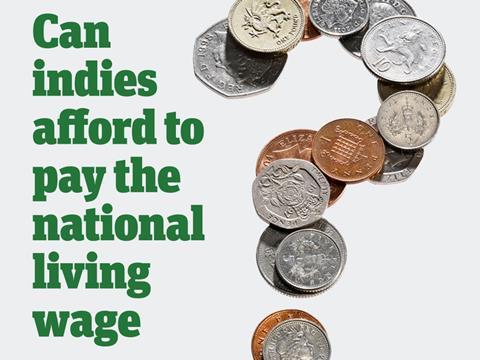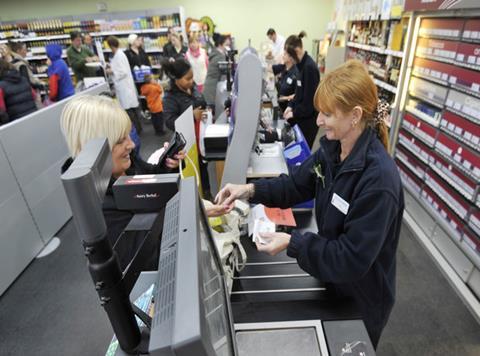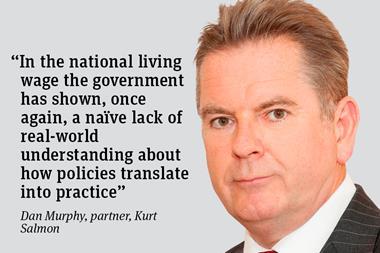
For George Osborne, April will be just another month spent battling Brexit and Boris, but for indies it poses a more significant challenge in the shape of the chancellor’s national living wage (NLW).
From 1 April anyone aged over 25 who works at one of the UK’s 51,000 c-stores will be paid at least £7.20 per hour, a 7% rise on the current national minimum wage.
And despite having nine months to digest the chancellor’s 2015 Budget bombshell, many retailers are worried. Nearly half (46%) are anxious about their ability to afford it, according to The Grocer’s exclusive poll (see over), while 14% say it will be “disastrous”. So how much will the NLW cost? And how can independents ease the burden?
There’s no doubt the introduction of the NLW will cost the sector big. According to the Association of Convenience Stores it will cost convenience retailers £167m in 2016 alone rising to a total of £925m by the time the Chancellor reaches his £9 per hour target in 2020. To put it another way, individual stores face having to find an extra £4,700 per employee per year within four years.
That doesn’t even take into account the cumulative impact of shifting up baseline pay. “To persuade an employee to accept or remain in a role as a manager or supervisor, there will need to be a sufficient gap between their pay and that of the most junior staff,” says Phil Allen, partner at Weightmans.

With 386,000 people employed in the sector (78% of which are over 25) this added cost hits the bottom line hard, says David McCorquodale, head of retail at KPMG. “Retail is a fixed cost business and the biggest costs you have are your rent, your rates and your people. When you get an increase to any of those you’re faced with pressure on your profitability.”
It’s also “more staff-intensive running smaller stores” adds ACS chief executive James Lowman, leaving c-stores “disproportionately” impacted compared with the mults despite help from the small business rate relief announced last month (see box, over).
Profits at forecourts and larger c-stores could be hit by as much as 25% with the arrival of the NLW. Average net profit at these stores is £36,000, according to ACS figures, with the NLW costing each up to £9,000 per year. Smaller commuter stores could suffer even more with average profit margins of 2%, or £12,000 per year, and staff their biggest cost.
“Already wage costs have been going up ahead of inflation for many years and small retailers have borne the brunt. As a result they’ve taken a lot of mitigating measures,” says Lowman. “They’ve been cutting unnecessary staff hours and trying to invest in labour savings. So it’ll be a significant cost to the business and there’s no easy way around that.”
And 2016 is only the start. The chancellor has pledged that the NLW will reach 60% of average income by 2020, a figure that the Low Pay Commission estimates will be £9.16 per hour. To get there will require a pay rise of 6% to the hourly rate every year for the next four years.
“A typical minimum wage worker will receive an additional £340 for the increase to £7.20, and about £1,175 for the increase to £9.16, relative to what they would have earned through forecast average earnings growth,” said the LPC in a report released last month.
Osborne promised to leave yearly rises up to the independent LPC, but as it was the chancellor who set the 60% target their “hands are tied” says Lowman. Moreover “the politicisation of it all makes it difficult for retailers to have faith in what’s going to come up next”.
But like it or loathe it, small retailers must adapt. Penalties for non-compliance can be as high as £20,000 per worker. And HMRC has set up a crack team to hunt down the most serious cases and name and shame offenders. So how do c-stores plan to cope?
Some simply won’t, believes Lowman. “Stores will close because of the NLW as they won’t be profitable any more,” he says. Closures are already happening. According to the BRC, independent retailers have gone into decline for the first time since 2012 with the number shutting down outstripping those opening up in 2015. And even if they stave off closure, for many more the NLW will mean cutting staff or staff hours, with one in five already considering the move, according to our poll. “They are already pretty lean in terms of store models but they’ll take an even harder look at those staff hours,” says Lowman.
Don’t fall foul of the law
At the same time, independents need to be careful not to fall foul of the law, warns Allen. “While it is unlawful to dismiss an employee because they qualify for the national living wage, it is potentially fair to dismiss due to a reduced need for staff, ” he says. However “retailers need to ensure a fair selection procedure is followed and a fair process of meetings takes place”.
They’ll also need to guard against complaints of age discrimination. “Rejecting job applicants due to their age carries the risk of a claim, and dismissing someone because they are over 25, or approaching that age, will be high risk,” he adds.
Passing the cost on to consumers by higher prices is no less risky, though - a strategy 9% of store owners say they’re considering. “We’ve got to be careful,” cautions Budgens retailer Andrew Thornton. “We can’t just lop 2% on our prices to recover the money as the danger is that would put us out of line with rival businesses.”
McCorquodale says “price increases are probably the option of last resort. There’s always another c-store selling jam, bread and milk 100 yards up the road, plus a big grocer a quarter of a mile away, so consumers are very capable of seeing the price differential.”
There are smarter ways to mitigate the NLW burden, he adds. For instance, pay packages in retail aren’t simply an hourly rate, he points out. They include pensions, staff discounts, overtime and paid breaks that workers often don’t take into account. “By taking the opportunity to change communications and make sure employees are well aware of other benefits they’re getting,” small retailers may be able to narrow the pay gaps between workers and lower the overall cost of their wage bill. “It’s forcing a look at the whole HR model and driving better HR behaviour,” he adds.
Thornton did just that when planning how to implement the NLW in his Belsize Park store. “We’ve reviewed our whole approach to pay and pay structures,” he says. “We’ve introduced a transparent pay system and better review process so everybody is really clear where they are now and what they would need to do to progress.”

Fair pay
With 80 staff working at his Belsize Park store, paying the basic NLW will add £65,000 to the store’s annual wage bill. But in applying the new wage universally (ie to those under 25) and “paying as many people as possible ahead of the legal requirement”, it will cost “quite a bit more” he adds.
So why do it? “We’re on a journey to being a more heartful business and that means fair pay,” says Thornton - although another factor is concern at losing staff to larger retailers better equipped to go above and beyond, such as Lidl, which pays staff £8.25 per hour.
Reviewing shop floor processes to boost staff productivity can also help retailers cope, adds Emily Kenway, campaign manager at the Living Wage Foundation. She recommends cross-training, which abolishes the split between cashiers, shelf stackers and backroom staff and trains staff in all tasks. “It means you’re getting more bang for your buck per employee and able to meet the flows of a retail business better,” she says. Retailers could also standardise tasks with clearly defined protocol on each step to “minimise scope for human error” and improve efficiency, a strategy already employed by large retailers and manufacturers.
And as damaging as the NLW may seem, better paid workers may bring about benefits. Admittedly a legal wage floor is unlikely to herald a “drop in customer complaints and better staff retention but it may be that people getting a pay rise are able to make ends meet more, which could reduce stress and abseentism” she adds. According to a BIS survey in January, 59% of employees say they’ll feel “more motivated” to work thanks to the 50p per hour rise.
No doubt that’s the line Osborne will be peddling as he fends off critics in the coming weeks. Painful or not, “Britain deserves a pay rise,” declared the Chancellor in 2015. And nine months on all small retailers must now deliver it.
Does business rate relief for small businesses help?

Osborne’s Budgets haven’t all been bad news for small business. Hidden among the controversial cuts to disability benefits and tax breaks last month was the permanent extension of the chancellor’s small business rate relief.
The move means 600,000 small businesses now won’t pay business rate tax, giving them an annual saving of more than £6,000, while a further 250,000 firms will see their rates cut, according to the government.
“In total, half of all British properties will see their business rates fall or be abolished altogether,” announced the Chancellor to roars of approval in the Commons on 16 March. “It’s a big tax cut for small firms. All in a Budget that backs small business.”
The change means relief threshold has more than doubled and all properties with a rateable value of less than £15,000 will benefit from exemptions to costly business rates, a change that will impact many small c-stores.
Many more will benefit from the higher rate relief, which has risen from £18,000 to £51,000. The permanent increase in rate relief has long been called for by small business lobby groups, with Osborne previously extending relief on a temporary basis. The change hasn’t come soon enough, according to the Federation of Small Business, which says small business confidence is at its lowest levels since 2013.
“Small business confidence has clearly faltered, which is why the welcome small business focus in the Budget is so important,” says FSB vice chairman Sandra Dexter. “These measures should help to boost confidence and help small firms to grow and succeed. We need a renewed push for growth and productivity.”
The policy won’t come cheap, however. The net cost to the Treasury will add up to £6.7bn over the next five years, making it the most costly of Osborne’s business handouts. But the fact he says he’ll fund the relief with a crackdown on multinationals swerving corporation tax will no doubt make small retailers even happier.
Business barometer
Do you support the introduction of the national living wage?
● Yes 66%
● No 34%
Do you already pay all staff the national living wage rate of £7.20 per hour or higher?
● No 58%
● Yes 42%
Are you concerned about your ability to pay the national living wage?
● No 54%
● Yes 46%
What is the main way you will make savings to pay for the national living wage?
● It won’t affect me 41%
● I’ll need to cut my staff hours 15%
● I’ll put up prices 9%
● I’ll extend my opening hours 3%
● All of the above 24%
What impact do you think the national living wage will have on your business long term?
● Mild to moderate 45%
● No impact at all 41%
● Disastrous 10%
● It could force me to close down 4%



















No comments yet